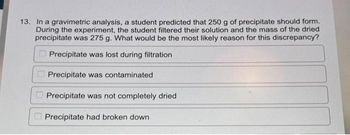
Chemistry
10th Edition
ISBN: 9781305957404
Author: Steven S. Zumdahl, Susan A. Zumdahl, Donald J. DeCoste
Publisher: Cengage Learning
expand_more
expand_more
format_list_bulleted
Concept explainers
Question
thumb_up100%
Please answer fast i give you upvote.

Transcribed Image Text:13. In a gravimetric analysis, a student predicted that 250 g of precipitate should form.
During the experiment, the student filtered their solution and the mass of the dried
precipitate was 275 g. What would be the most likely reason for this discrepancy?
Precipitate was lost during filtration
Precipitate was contaminated
Precipitate was not completely dried
Precipitate had broken down
Expert Solution
This question has been solved!
Explore an expertly crafted, step-by-step solution for a thorough understanding of key concepts.
This is a popular solution
Trending nowThis is a popular solution!
Step by stepSolved in 3 steps

Knowledge Booster
Learn more about
Need a deep-dive on the concept behind this application? Look no further. Learn more about this topic, chemistry and related others by exploring similar questions and additional content below.Similar questions
- Chrome File Edit View History Bookmarks Profiles Tab Window Help - с Aktiv Chemistry LOD TRANSHITTANCETT app.101edu.co 50 esc 1 D 4000 X 2 + 3000 Compound 1 CEN 1,506 # 3 $ 2000 Compound 2 4 O JUN 30 HAVENUMBERI-11 do 5 % 1500 OH Compound 3 O < 6 121 MacBook Pro PAGES & 7 mm 1000 W Compound 4 * при OH 8 ( 9 500 434 G 0 ☆arrow_forwardAnswer questions #4 please provide and explanation. Thank you.arrow_forwardOnly Typed Solution.arrow_forward
- Insert Draw Design Layout References Mailings Review View Help B Share O Comments O Find v (Body) 11 A A Aav Ao 、、に、王E会↓ T AaBbCcDc AaBbCcDc AABBCC AaBbCcC AaB S Replace Dictate Sensitivity Editor 三=== =、の、 T Normal T No Spac... Heading 1 Hling 2 Title - ab x, x A evAv A Select v Paragraph Styles Editing Voice Sensitivity Editor Font 1. For each of the following changes at equilibrium, indicate whether the equilibrium shifts in the direction of the product, the reactants, or does not change I. N2 (g) + 0, (g) + heat 2NO (g) a. Increasing the temperature - b. Decreasing the volume of the container c. Adding a catalyst - d. Adding more N2 (g) С. 180% D Focus 2:29 PM prds 70% 11/10/2020 pe here to search Insert belete PriSc F11 F12 F10 F9 F8 F7 Backspaca F6 127 1> 人arrow_forwardCompute the ionization potential of a positronium (an "atom" made by an electron bonded to a positron). SHOW FULL AND COMPLETE PROCEDURE IN AN ORDERED WAYarrow_forwardJust part b!!!arrow_forward
- help please answer in text form with proper workings and explanation for each and every part and steps with concept and introduction no AI no copy paste remember answer must be in proper format with all workingarrow_forwardstate if true or false 1. Considering that concentration and the size of sample container are the same, a sample with a higher molar absorptivity will have a higher TRANSMITTANCE than a sample with the lower E (molar absorptivity). 2. Considering that concentration and the size of sample container are the same, a sample with a higher molar absorptivity will have a higher ABSORBANCE than a sample with the lower E (molar absorptivity). 3. The higher the concentration of a sample is the higher the transmittance will be. 4. Spectrophotometry is the study of how light interacts with matter 5. During an absorbance reading, light must pass through the opaque side of the cuvette. 6. Distilled water is an acceptable blank solution for any samplearrow_forwardIdentify the following spectra. Full credit is only given if all pertinent peaks are assigned on the spectrum (~5-6 peaks). Label the peaks on the spectrum and place the structure of the compound in the box on the lower left-hand corner of the spectrum. please on the graph circle the peakarrow_forward
arrow_back_ios
SEE MORE QUESTIONS
arrow_forward_ios
Recommended textbooks for you
 ChemistryChemistryISBN:9781305957404Author:Steven S. Zumdahl, Susan A. Zumdahl, Donald J. DeCostePublisher:Cengage Learning
ChemistryChemistryISBN:9781305957404Author:Steven S. Zumdahl, Susan A. Zumdahl, Donald J. DeCostePublisher:Cengage Learning ChemistryChemistryISBN:9781259911156Author:Raymond Chang Dr., Jason Overby ProfessorPublisher:McGraw-Hill Education
ChemistryChemistryISBN:9781259911156Author:Raymond Chang Dr., Jason Overby ProfessorPublisher:McGraw-Hill Education Principles of Instrumental AnalysisChemistryISBN:9781305577213Author:Douglas A. Skoog, F. James Holler, Stanley R. CrouchPublisher:Cengage Learning
Principles of Instrumental AnalysisChemistryISBN:9781305577213Author:Douglas A. Skoog, F. James Holler, Stanley R. CrouchPublisher:Cengage Learning Organic ChemistryChemistryISBN:9780078021558Author:Janice Gorzynski Smith Dr.Publisher:McGraw-Hill Education
Organic ChemistryChemistryISBN:9780078021558Author:Janice Gorzynski Smith Dr.Publisher:McGraw-Hill Education Chemistry: Principles and ReactionsChemistryISBN:9781305079373Author:William L. Masterton, Cecile N. HurleyPublisher:Cengage Learning
Chemistry: Principles and ReactionsChemistryISBN:9781305079373Author:William L. Masterton, Cecile N. HurleyPublisher:Cengage Learning Elementary Principles of Chemical Processes, Bind...ChemistryISBN:9781118431221Author:Richard M. Felder, Ronald W. Rousseau, Lisa G. BullardPublisher:WILEY
Elementary Principles of Chemical Processes, Bind...ChemistryISBN:9781118431221Author:Richard M. Felder, Ronald W. Rousseau, Lisa G. BullardPublisher:WILEY

Chemistry
Chemistry
ISBN:9781305957404
Author:Steven S. Zumdahl, Susan A. Zumdahl, Donald J. DeCoste
Publisher:Cengage Learning

Chemistry
Chemistry
ISBN:9781259911156
Author:Raymond Chang Dr., Jason Overby Professor
Publisher:McGraw-Hill Education

Principles of Instrumental Analysis
Chemistry
ISBN:9781305577213
Author:Douglas A. Skoog, F. James Holler, Stanley R. Crouch
Publisher:Cengage Learning

Organic Chemistry
Chemistry
ISBN:9780078021558
Author:Janice Gorzynski Smith Dr.
Publisher:McGraw-Hill Education

Chemistry: Principles and Reactions
Chemistry
ISBN:9781305079373
Author:William L. Masterton, Cecile N. Hurley
Publisher:Cengage Learning

Elementary Principles of Chemical Processes, Bind...
Chemistry
ISBN:9781118431221
Author:Richard M. Felder, Ronald W. Rousseau, Lisa G. Bullard
Publisher:WILEY